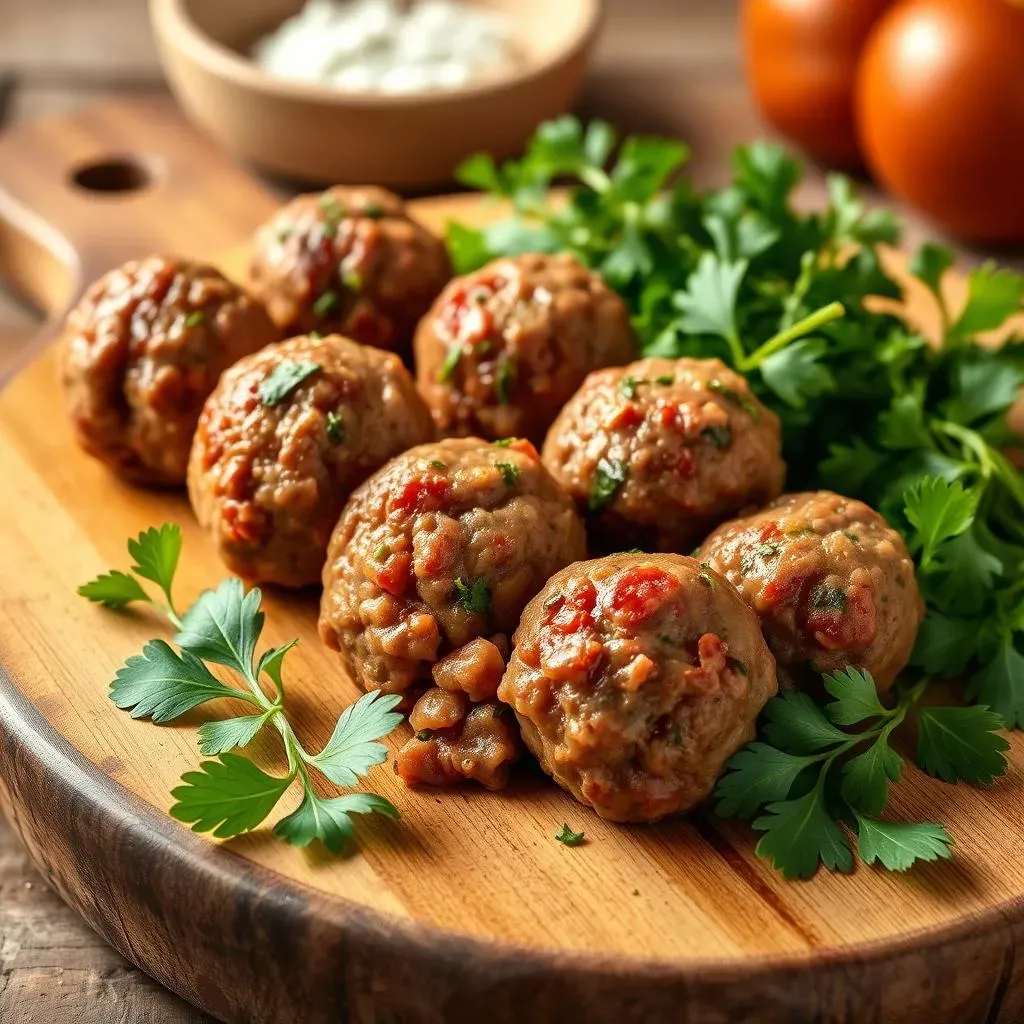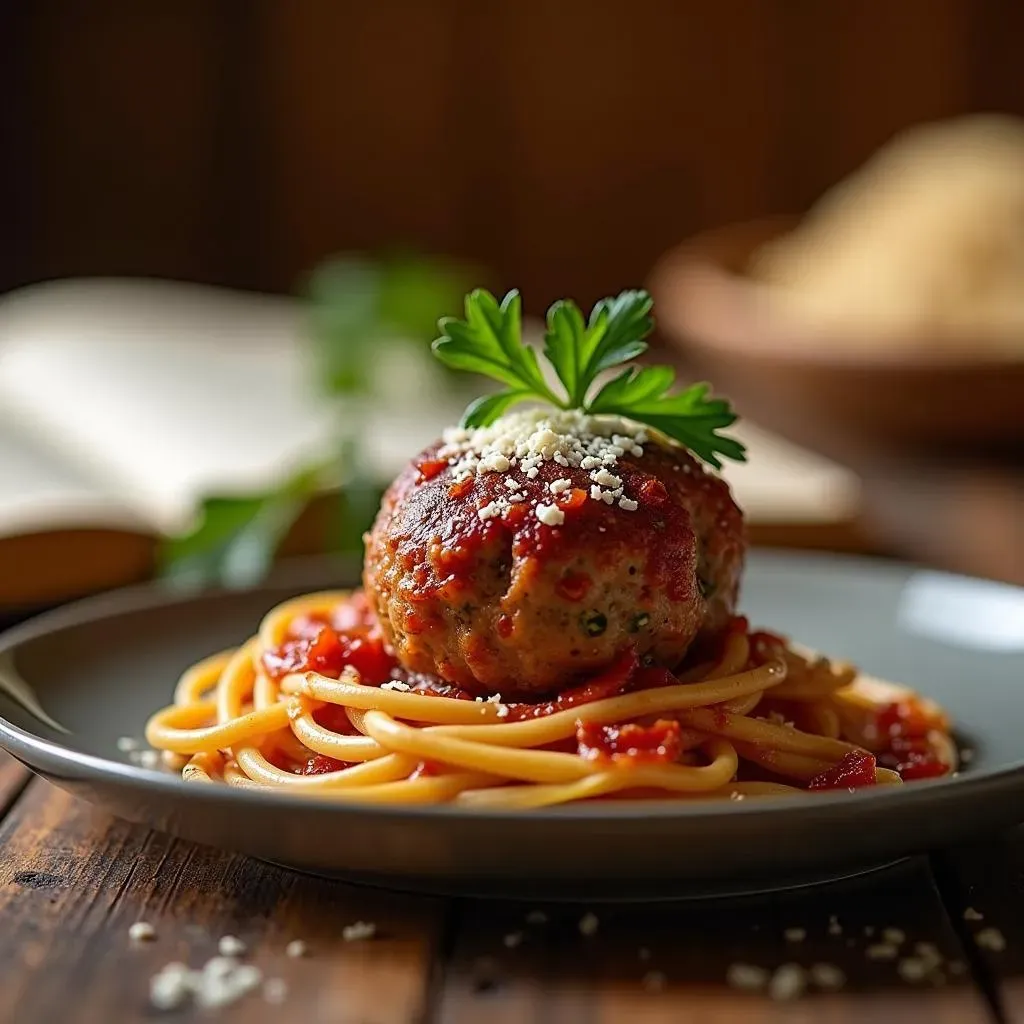Table of Contents
Are you ready to discover the *best meatball recipe with beef and pork*? Forget everything you think you know about meatballs – we're about to take your taste buds on a culinary adventure! This isn't just another meatball recipe; it's a journey to meatball perfection. We'll explore the ideal blend of beef and pork for maximum juiciness and flavor, revealing secret ingredients that elevate these humble spheres to new heights. Get ready to learn the best cooking methods – from oven-baked to pan-fried to slow-simmered – ensuring your meatballs are flawlessly cooked every time. And finally, we’ll go beyond the classic spaghetti and meatballs, showcasing creative and delicious serving suggestions that will impress even the most discerning meatball aficionado. So, grab your aprons, gather your ingredients, and prepare for a meatball experience unlike any other. Let's get cooking!
The Perfect Meatball Mix: Beef and Pork Powerhouse

The Perfect Meatball Mix: Beef and Pork Powerhouse
The Beef-Pork Ratio: Finding the Sweet Spot
So, you're diving into the world of meatball making, huh? Fantastic! The first thing we need to talk about is the star of the show: the meat. For the absolute best flavor and texture, a blend of beef and pork is your secret weapon. Think of it like this: the beef provides a rich, savory base, while the pork adds incredible juiciness and a touch of sweetness. It's a match made in meatball heaven!
Now, the ratio is key. Too much beef, and you might end up with dry meatballs. Too much pork, and they could be a bit greasy. I've experimented a lot, and my personal favorite is a 50/50 blend. It's the perfect balance of flavor and texture. But feel free to experiment! Some people prefer more beef for a stronger, meatier flavor. For a richer, more tender meatball, check out our best Italian meatball recipe with beef, pork, and veal. You can always adjust the ratio to suit your taste.
Meat Type | Percentage | Flavor Profile |
|---|---|---|
Ground Beef | 50% | Savory, Rich |
Ground Pork | 50% | Sweet, Juicy |
Beyond the Basics: Exploring Different Cuts
Okay, so we've got the ratio sorted, but let's delve a little deeper. Not all ground beef and pork are created equal. The type of ground meat you choose will significantly impact the final result. For example, using a leaner ground beef will result in a firmer meatball, while a fattier cut will create a more tender, juicy one. Similarly, the fat content in your ground pork will influence its moisture level. If you want a leaner meatball, you can use lean ground beef and pork. If you want a richer, more flavorful meatball, use a higher-fat content ground beef and pork.
For the ultimate in meatball deliciousness, I recommend using a blend of ground beef chuck and sirloin. The chuck provides richness and moisture, while the sirloin adds a subtle sweetness and leanness. For the pork, I prefer a blend of shoulder and loin. The shoulder provides tenderness and moisture, while the loin offers a more delicate flavor. Think of it as a symphony of flavors and textures working together to create the perfect bite. If you want a simple recipe that's also delicious, check out our easy ground beef meatball recipe.
- Ground Beef Chuck: Rich, moist
- Ground Beef Sirloin: Lean, subtle sweetness
- Ground Pork Shoulder: Tender, moist
- Ground Pork Loin: Delicate flavor
Secret Ingredients for Juicy, Flavorful Meatballs

Secret Ingredients for Juicy, Flavorful Meatballs
The Magic of Breadcrumbs
Okay, let's talk breadcrumbs. They're not just filler; they're the secret to incredibly juicy and tender meatballs! Think of them as tiny little sponges, soaking up all that delicious moisture and keeping your meatballs from drying out. I prefer using fresh breadcrumbs, but panko works great too. And here's a pro tip: soak your breadcrumbs in milk or even better, a mixture of milk and an egg for extra richness before adding them to the meat mixture. This simple step makes a world of difference!
Don't underestimate the power of a good soak! It's the key to achieving that perfect, melt-in-your-mouth texture. Experiment with different types of milk – whole milk adds richness, while buttermilk provides a slightly tangy flavor. For a truly unique twist, try soaking your breadcrumbs in a mixture of milk and grated Parmesan cheese. You'll be amazed at the result! For even more meatball inspiration, check out our best meatball recipe using ground beef.
Breadcrumb Type | Liquid | Result |
|---|---|---|
Fresh Breadcrumbs | Milk | Classic, moist |
Panko | Milk & Egg | Crispy exterior, juicy interior |
Flavor Boosters: Herbs, Spices, and More
Now, let's talk flavor! Don't be shy with the herbs and spices. A classic Italian meatball blend typically includes garlic, onion, parsley, oregano, and basil. But feel free to get creative! A pinch of red pepper flakes adds a nice kick, while a dash of nutmeg provides a warm, comforting aroma. And don't forget about the cheese! Grated Parmesan cheese is a must-have, but you can also experiment with other cheeses like Pecorino Romano or even a little bit of ricotta. The possibilities are endless!
I like to finely chop my garlic and onion and sauté them lightly before adding them to the meat mixture. This step helps to release their aromatic oils, resulting in a more flavorful meatball. Consider adding a splash of dry white wine to your meatball mixture for extra depth and complexity. Or, for a fun twist, try adding some finely chopped sun-dried tomatoes. For a simple yet delicious meatball recipe, check out our easy beef meatballs recipe. Remember, flavor is key, so don't be afraid to experiment!
- Garlic: Aromatic, pungent
- Onion: Sweet, savory
- Parsley: Fresh, herbaceous
- Oregano: Earthy, slightly bitter
- Basil: Sweet, peppery
The Binding Agent: Eggs and More
Finally, let's talk about binding agents. Eggs are a classic choice, helping to hold the meatballs together and add richness. However, you can also use other binding agents, such as finely grated zucchini or even mashed potatoes! These alternatives add moisture and help create tender meatballs. They also add a subtle sweetness and moisture, making the meatballs incredibly juicy. Remember, the goal is to create a mixture that's firm enough to hold its shape but not so dry that it crumbles.
Adding a little bit of egg to your meatball mixture is a classic technique that helps bind the ingredients together and create a more cohesive meatball. However, if you're looking for a gluten-free option, you can try using a flax egg (one tablespoon of ground flaxseed meal mixed with three tablespoons of water). For a truly unique experience, you could even experiment with adding a small amount of finely grated potato to your mixture. This adds moisture and a subtle sweetness! Don't be afraid to get creative. For another great meatball recipe, check out our beef, pork, and veal meatball recipe.
"The perfect meatball is a delicate balance of flavor, texture, and technique. Don't be afraid to experiment and find what works best for you!" - Anonymous Meatball Enthusiast
Cooking Methods: OvenBaked, PanFried, or SlowSimmered?

Cooking Methods: OvenBaked, PanFried, or SlowSimmered?
Choosing Your Meatball Cooking Method
Alright, friend, we've crafted the perfect meatball mixture. Now, the big question: how do we cook these beauties? Each method brings a unique character to the table, so let's explore the options. Oven baking delivers consistently cooked meatballs, perfect for a crowd. Pan-frying offers a delightful crispy exterior, ideal for a smaller batch or a quick weeknight meal. And slow simmering in a rich sauce? Well, that's pure comfort food heaven!
Oven baking is great for large batches and ensures even cooking. Simply place your meatballs on a baking sheet, bake at 375°F (190°C) for about 20-25 minutes, or until cooked through. For a simpler recipe, check out our baked beef meatball recipe. Pan-frying, on the other hand, gives you those gorgeous browned bits and a satisfying texture. Heat a little oil in a large skillet over medium heat, and cook the meatballs for about 8-10 minutes, turning occasionally, until golden brown and cooked through. Finally, simmering in a rich sauce is the ultimate in cozy comfort. Gently simmer your meatballs in your favorite sauce for at least 30 minutes, allowing them to absorb all that delicious flavor. This method is perfect for a slow-cooked meal.
Cooking Method | Pros | Cons |
|---|---|---|
Oven-Baked | Even cooking, large batches | Can be a bit dry |
Pan-Fried | Crispy exterior, quick cooking | Requires attention, smaller batches |
Slow-Simmered | Maximum flavor absorption, tender meatballs | Time-consuming |
Temperature and Doneness
Regardless of your chosen method, using a meat thermometer is crucial for ensuring perfectly cooked meatballs. Aim for an internal temperature of 165°F (74°C). Overcooked meatballs become dry and tough, while undercooked ones are, well, unsafe. This is where a meat thermometer becomes your best friend. It takes the guesswork out of cooking, ensuring perfectly cooked meatballs every time. A simple poke with a fork isn't reliable; the thermometer provides an accurate reading of the internal temperature. I cannot stress this enough!
Remember, the cooking time will vary depending on the size of your meatballs and your chosen cooking method. Smaller meatballs will cook faster than larger ones. Always err on the side of caution and check the internal temperature before removing them from the heat. For another delicious option, try our beef meatballs in sauce recipe – the simmering method truly brings out the best flavors. Once cooked, let the meatballs rest for a few minutes before serving. This allows the juices to redistribute, resulting in extra tender and juicy meatballs.
- Use a meat thermometer to ensure an internal temperature of 165°F (74°C).
- Adjust cooking time based on meatball size and cooking method.
- Let meatballs rest for a few minutes after cooking.
Serving Suggestions: Beyond Spaghetti and Meatballs

Serving Suggestions: Beyond Spaghetti and Meatballs
Meatball Subs: A Flavorful Twist
Let's face it, spaghetti and meatballs is a classic for a reason. But sometimes, you crave a change of pace. Meatball subs are a fantastic alternative, offering a handheld, flavorful experience. Imagine the juicy meatballs nestled in a crusty roll, layered with melted mozzarella cheese, and drizzled with your favorite sauce. It's a satisfying meal that's perfect for a casual lunch or a quick weeknight dinner. The best part? You can customize it to your heart's content!
Think beyond marinara. Try a spicy arrabbiata sauce for a kick, or a creamy pesto sauce for a fresh, vibrant twist. Add some sautéed peppers and onions for extra flavor, or a sprinkle of fresh herbs for an aromatic touch. For another delicious option, check out our beef meatballs in sauce recipe, which is easily adaptable for subs. The possibilities are endless! Don't be afraid to experiment and find your perfect meatball sub combination.
Roll Type | Sauce | Cheese |
|---|---|---|
Hoagie Roll | Marinara | Mozzarella |
Italian Bread | Pesto | Provolone |
Meatball Bowls: A Hearty and Healthy Option
For a healthier and more customizable option, consider meatball bowls. These are incredibly versatile and let you showcase the deliciousness of your meatballs while incorporating a variety of fresh ingredients. Think quinoa or brown rice as a base, topped with your perfectly cooked meatballs, a medley of roasted vegetables like zucchini, bell peppers, and onions, and a vibrant, zesty dressing. You can easily control the portion sizes and the nutritional value, making it a guilt-free indulgence.
The beauty of meatball bowls lies in their adaptability. Experiment with different grains, such as farro or couscous, and try various vegetables to create a unique flavor profile. Consider adding a sprinkle of toasted nuts or seeds for added crunch, or a dollop of Greek yogurt for a creamy, tangy touch. For a simple yet flavorful meatball recipe perfect for bowls, check out our easy beef meatballs recipe. With meatball bowls, your creativity is the only limit. Let your imagination run wild!
- Quinoa or brown rice
- Roasted vegetables (zucchini, bell peppers, onions)
- Toasted nuts or seeds
- Zesty dressing (lemon vinaigrette, tahini dressing)
Meatball Skewers: Fun and Festive
Looking for a fun and festive way to serve your meatballs? Meatball skewers are the perfect solution! These bite-sized delights are ideal for parties, barbecues, or any occasion where you want to offer a unique and shareable appetizer. Simply thread cooked meatballs onto skewers, alternating them with cherry tomatoes, cubes of cheese, or pieces of grilled vegetables. The possibilities are endless, and the presentation is always a showstopper.
For an extra touch of flavor, marinate the meatballs in your favorite sauce before threading them onto the skewers. Consider using a balsamic glaze, a teriyaki sauce, or even a spicy sriracha mayo. For a simple yet delicious meatball recipe that's perfect for skewers, check out our mini beef meatball recipe. These are easy to make and always a crowd-pleaser. Remember to serve with toothpicks for easy eating. Get creative and have fun with it!
"The best meatball is the one you enjoy the most. So experiment, have fun, and most importantly, savor every bite!" - Unknown